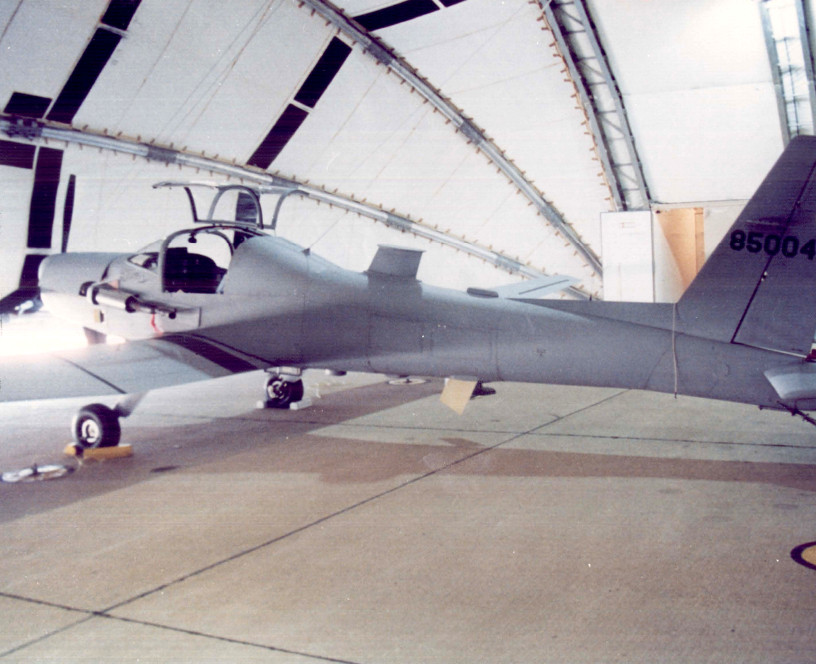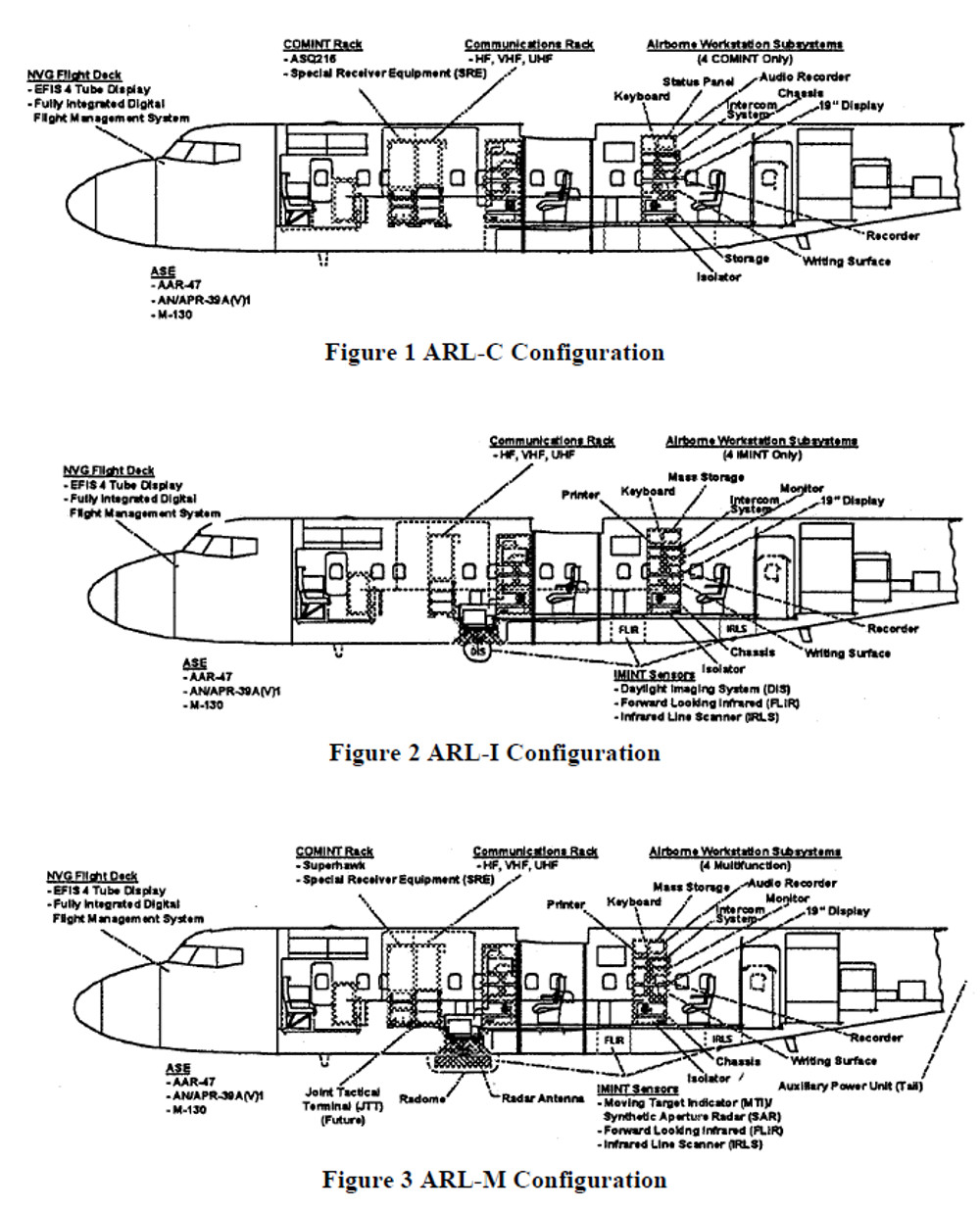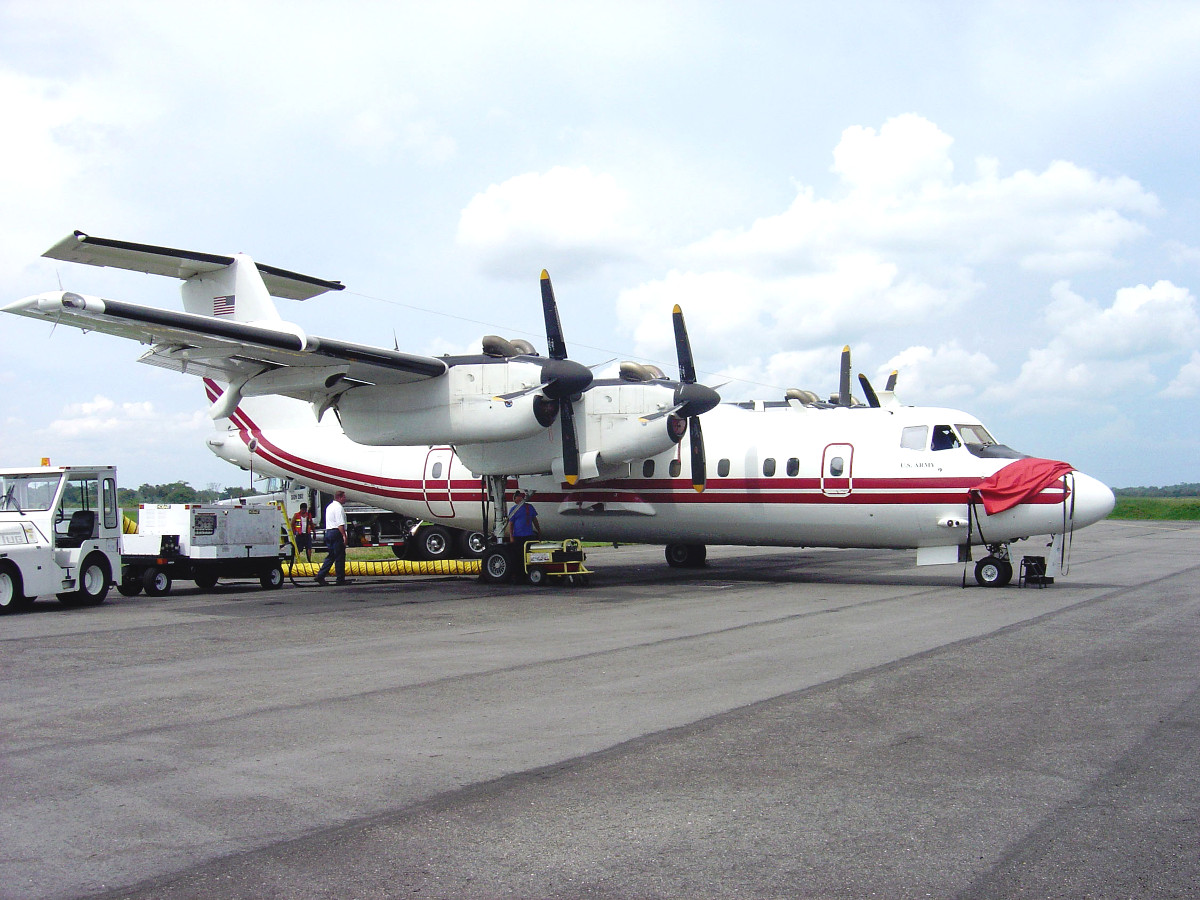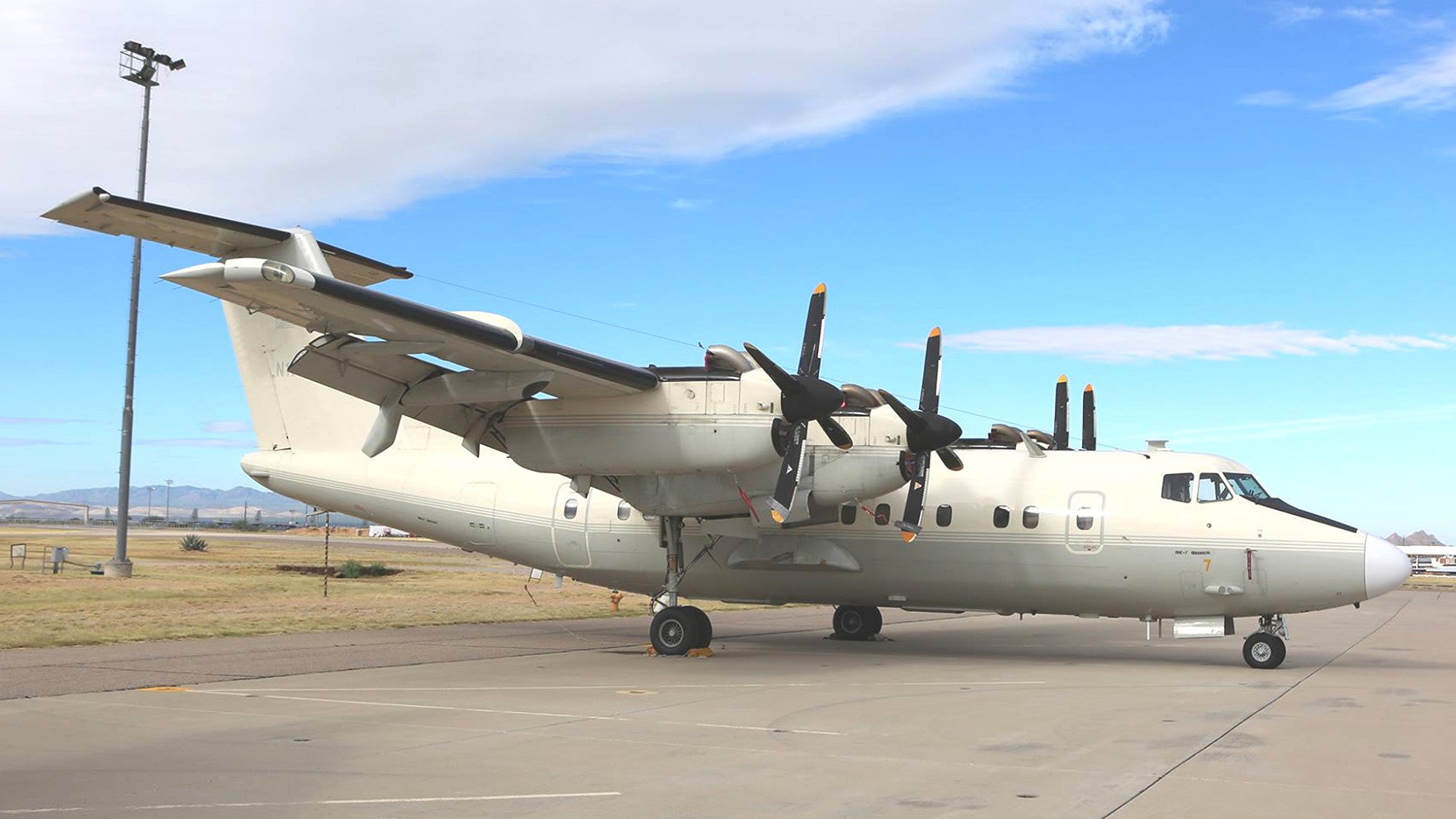The U.S. military’s famous boneyard at Davis-Monthan Air Force Base houses more than 3,600 airframes in various types of storage, either as spares, sources of parts, or otherwise awaiting a new life or the junk heap. Now, it’s also home to two particularly secretive de Havilland Canada DHC-7 spy planes.
On Sept. 22, 2017, the 309th Aerospace Maintenance And Regeneration Group, the U.S. Air Force unit that manages the facility, posted pictures of a number of recent arrivals, including a P-3C Orion patrol plane, a C-130H airlifter, a C-20B business jet, and an MH-60R helicopter. Another photo showed a DHC-7. To the casual observer, there might not appear to be anything special about this white-and-gray four engine plane, especially with much of its special equipment apparently removed, but it has had a long and still largely unknown career.
A surprise appearance
On Facebook, the 309th referred to the aircraft by the serial number 00-000076. In an Email, a public affairs officer for the unit provided information that showed it had arrived in the desert on Aug. 8, 2017. A second DHC-7, with the serial number 00-000056 had touched down nearly a year earlier, on Aug. 29, 2016, according to an official table of all of the aircraft in the boneyard.
These two aircraft are much more commonly known by the civil registration codes N176RA and N566CC. While the Federal Aviation Administration issued those registrations to the Army’s Aberdeen Proving Ground in Maryland, the N176RA apparently went to Arizona by way of the Maryland Army National Guard in Hagerstown on the other side of the state, the 309th’s public affairs official said.
Who had been flying these two planes and in support of what operations remains something of a mystery. In 2011, both N176RA and N566CC flew missions out of Kandahar Air Base in Afghanistan. Observers noticed at least one of the aircraft flying routinely over Benghazi, Libya in 2016, a hotbed of terrorist activity and an area of intense American military interest after the infamous assault on the U.S. consulate there in 2012. One was seen over Derna, Libya, east of Benghazi, in January 2017. Those missions likely originated in Malta.
But there is no doubt that they had been intelligence, surveillance, and reconnaissance platforms. For years, plane spotters have caught both N176RA and her sister crisscrossing the world, particularly during stopovers at commercial airports in Europe. They snapped pictures showing an array of blisters, bumps, antennas, and other features well associated with spy planes.
Radomes underneath the fuselage would undoubtedly have held some sort of radar, likely able to produce imagery, spot and tracking moving targets, or both. Fairings on either side might hold additional radars or simply serve as a mounting point for other antennas.
The array of aerials underneath and along the sides could form a signals intelligence system able to spot enemy radios and other emitters and possibly listen in on communications chatter. Sometimes they had a large dome on top that is common to satellite communications systems and datalinks, so the aircraft can share any information it collects in near real time. The planes also had infrared missile warning sensors and flare dispensers for self-protection.
But more interestingly, under the fuselage these aircraft had three additional sensor positions with sliding doors to protect them when they’re not in use. This type of installation generally houses some type of wide-angle visual or infrared camera, or a multi-optic wide-area aerial surveillance system.
The latter systems generally allow crews to take still imagery or full motion video of large sectors to help track targets and retrace their movements. Combined with a radar to spot moving objects, it is even easier for the aircraft to locate targets and monitor their movements, proving persistent imagery to help analysts build what is called “a pattern of life.” You can read more about the technology and this concept here. Similar installations have been spotted on other shadowy turboprop spy planes, like this CN235 that was operating over Seattle this Summer.
All of the radomes are gone and many of the antennas are missing from N176RA now that its at the boneyard. Its not clear from the available picture whether the ventral doors got sealed before or after it went into storage.
The Army’s other DHC-7s
And while we don’t know the exact configurations of the two aircraft, what units flew them, or what purposes, we have a number of clues that offer a good sense of what these planes were capable of and what types of missions they eventually found themselves on overseas. The U.S. Army’s use of the DHC-7 as an intelligence gathering platform is well established.
In March 1991, the Army hired California Microwave, Inc. to build the first version, which was only able to gather visual and infrared imagery, as part of the Grisly Hunter Program. The service had previously considered installing some or all of these sensors on a twin engine CASA 212 light transport and a single engine RG-8A powered glider, among other platforms. The aircraft had an electro-optical turret, a forward looking infrared system, and a wide-angle infrared line scanner camera in three separate positions along the bottom of the fuselage behind doors similar to what one sees on N176RA and N566CC.

The next month, the Army ordered two more DHC-7 spy planes with signals intelligence suites from the Maryland-based firm as part of a separate program called Crazy Panther. This pair dispensed with the underside ports and featured arrays of antennas instead.
The two types, known as the O-5A and EO-5B, quickly went off to hunt insurgents and drug runners in Latin America. The complete systems were called the Airborne Reconnaissance Low-Imagery Intelligence and Airborne Reconnaissance Low-Communications Intelligence, or ARL-I and ARL-C.

Eventually, the Army realized it was a waste to have two separate aircraft for these roles, and bought three more “multi-sensor” ARL-Ms under yet another project called Crazy Hawk. Though they retained most of the systems found on both of the earlier ARL types, these planes, initially called RC-7Bs and then renamed EO-5Cs, swapped out the camera turret for a Hughes synthetic aperture radar in a retractable radome, which was able to produce imagery and monitor moving targets. The first of these types went to the Korean Peninsula in 1996 to keep watch over the demilitarized zone, where they still fly today.
Over the years, the Army steadily upgraded and improved the systems, including adding electro-optical turrets back onto some of the EO-5Cs. By 2002, the fleet had also expanded to seven total operational aircraft, along with a single trainer type. All of these planes wear a white paint scheme with a pair of red stripes running down the sides of the fuselage.

Given the obvious similarities, N176RA and N566CC get described as EO-5Cs all the time, but we know they’re not. We can account for all eight ARL-M aircraft and all of their civil registrations are publicly available. Five of them are with the 204th Military Intelligence Battalion at Fort Bliss in Texas and the other three are part of the 3rd Military Intelligence Battalion in South Korea.


A curious history
Exactly how the other two DHC-7s came into their role as spy planes isn’t entirely clear. We do know that N176RA spent at least some time with the Joint Precision Strike Demonstration (JPSD) Project Office, an obscure organization that came into existence in 1991 as part of a larger Pentagon-wide program known as the Precision Strike Thrust.
This “thrust” was “a set of integrated capabilities, from sensors to shooters, to locate, identify and kill high-value, time-sensitive, tactical targets, in adverse weather conditions, day or night, and to provide the Commander with near real-time battle damage assessment,” according to a 1994 Army report. The JPSD was the Army’s part of that initiative, which tested everything from long-range rocket artillery to airborne sensors, including synthetic aperture imaging radars, as well as some of the very first Predator drones.
In 2003, a plane spotter caught a glimpse of N176RA wearing an overall white paint scheme similar to the EO-5C colors, but with green instead of red stripes. The aircraft also had the JPSD logo on the tail. A year earlier, the Department of Energy’s Sandia National Laboratory had produced high resolution maps using radar imagery a “DHC-7” from the JPSD program captured of the sites of the 2002 Winter Olympics in Park City, Utah, along with unspecified parts South Korea, Fort Bragg in North Carolina, and Washington, D.C. These images went to the Department of Defense, the Federal Emergency Management Agency, and multiple law enforcement agencies.
It is entirely possible that N176RA, along with N566CC, remained test beds for new sensor technology even after the end of the JPSD program. The DHC-7’s size would provide ample space for a variety of radars, laser imaging, still and video cameras, and other systems. For a time, both it and N566CC wore overall white paint schemes before switching to the final swhite-over-gray style, neither of which are particularly indicative or any service or unit.
It’s not uncommon for the U.S. military and other U.S. government organizations to send similar aircraft to actual conflict zones and hot spots to field test new equipment. NP-3D Orions from the U.S. Navy’s Scientific Development Squadron One (VXS-1) have made trips to Afghanistan and the Caribbean for geographic survey and surveillance missions. NASA’s unique WB-57F research aircraft have made similar deployments to Afghanistan and parts of Africa as a communications node.
Another possibility is that these aircraft quietly moved from the Army’s research and development world to the special operations community, joining a variety of other secretive aircraft supporting some of the most shadowy elements of the U.S. military, including the Joint Special Operations Command.
In March 2016, one of these planes, a contractor-flown Beechcraft King Air, crashed in Iraq. As with N176RA and N566CC, its civil registration, N6351V, pointed to Aberdeen Proving Ground.
The latest detail that these aircraft came to the boneyard from the Army National Guard suggests that they could have been attached to one of these reserve elements for at least a time. Both the Army and Air National Guard do deploy units overseas. Maryland’s Army National Guard does include a military intelligence battalion, as well as multiple special operations units, but none appear to have aviation components.
It’s also unclear whether the Army has put the two DHC-7s into storage permanently or if they already have plans to resurrect them at some point in the future. Whatever unit was flying them could easily have replaced them with a more advanced or otherwise newer system.
The aircraft is long out of production and the newest examples of the type are almost 30 years old. The Army as a whole is ditching the type in favor of intelligence gathering aircraft based on the Dash-8, a successor design that Bombardier, which bought de Havilland Canada in 1992, still produces in some configurations.
With so much still unknown, we’re going to keep digging into these curious aircraft ourselves, but if you have any additional details, feel free to leave them in the comments below.
Contact the author: joe@thedrive.com
